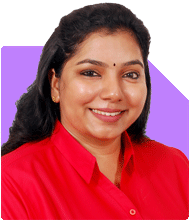54, Jobless, and Planning for Son's Marriage and Loan in Surat - How Can I Secure Our Finances?
Ramalingam Kalirajan |7438 Answers |Ask -Follow
Mutual Funds, Financial Planning Expert - Answered on Aug 23, 2024
He has an MBA in finance from the University of Madras and is a certified financial planner.
He is the director and chief financial planner at Holistic Investment, a Chennai-based firm that offers financial planning and wealth management advice.... more

Hi... I m 54 and having no job for last couple of yrs...my wife (47) and son (27) both hv been working and making appx 1.30L/pm, we have our own house in Surat and recently purchased a plot @63 L at Indore MP, In the next 5-6 years, we have to get our son married and clear the bank loan (49 lakh)...how will we plan our investment for that...now we are investing Rs 11500 per month in MF and there is an investment of 4L in stock mkt also..... we need apx 60 to 70 lakh
Key Financial Goals
Loan Repayment: Clearing the Rs 49 lakh loan.
Son's Marriage: Planning for a fund of Rs 60-70 lakhs in the next 5-6 years.
Evaluating Your Current Investments
Mutual Fund SIPs: Rs 11,500 per month is a good start, but considering your goals, you might need to increase this amount over time.
Stock Market Investments: Your Rs 4 lakhs in the stock market can be a good growth avenue, but it's essential to balance the risk.
Recommendations for Future Investments
1. Increase Mutual Fund SIPs
Consider increasing your SIPs gradually to match your income growth. This will help you accumulate more wealth over time.
Focus on a mix of large-cap and actively managed funds. They can offer stability and better returns over the long term.
Avoid direct funds and opt for regular funds through an MFD with CFP credentials for better guidance and support.
Monitor the performance of your funds regularly and adjust your investments if needed.
2. Rebalance Your Stock Market Portfolio
Assess your stock market investments. Given your time horizon, ensure you are not overexposed to high-risk stocks.
Consider diversifying your portfolio by adding more stable, blue-chip companies that offer consistent returns.
Regularly review your portfolio to ensure it aligns with your risk tolerance and financial goals.
3. Loan Repayment Strategy
Prioritise paying off the Rs 49 lakh loan. The interest you pay on the loan might exceed what you earn from investments.
Consider using a portion of your stock market or other liquid investments to pay off a chunk of the loan.
This will reduce your financial burden and free up more cash flow for future investments.
4. Prepare for Son's Marriage
Start a separate investment plan specifically for your son's marriage. Consider a balanced mutual fund that offers a mix of equity and debt.
Regularly increase the amount you set aside for this goal to ensure you reach your target of Rs 60-70 lakhs in the next 5-6 years.
Ensure you keep this fund accessible and relatively liquid as you approach the time of need.
Additional Considerations
1. Emergency Fund
Maintain a robust emergency fund covering at least 6 months of your family’s expenses. This fund should be in a liquid asset, such as a savings account or liquid mutual fund.
2. Health and Life Insurance
Ensure your family is adequately covered by health insurance, considering the rising healthcare costs.
Review your life insurance policies to ensure they provide sufficient coverage, particularly if you are the primary financial provider.
3. Retirement Planning
Although your immediate focus is on your son's marriage and loan repayment, do not neglect your retirement planning.
Ensure that you continue to build a retirement corpus that will sustain your lifestyle in your later years.
Consider shifting some of your equity investments to safer options as you approach retirement age.
Final Insights
Balancing your financial goals, such as loan repayment and your son's marriage, requires a well-thought-out strategy. Increasing your SIPs, strategically paying off your loan, and carefully planning your investments will help you achieve your goals within the next 5-6 years. Ensure you have sufficient insurance coverage and continue building your retirement fund.
Best Regards,
K. Ramalingam, MBA, CFP
Chief Financial Planner
www.holisticinvestment.in
You may like to see similar questions and answers below
Ramalingam Kalirajan |7438 Answers |Ask -Follow
Mutual Funds, Financial Planning Expert - Answered on May 05, 2024
Ramalingam Kalirajan |7438 Answers |Ask -Follow
Mutual Funds, Financial Planning Expert - Answered on Jul 04, 2024
Ramalingam Kalirajan |7438 Answers |Ask -Follow
Mutual Funds, Financial Planning Expert - Answered on Aug 20, 2024
Kanchan Rai |469 Answers |Ask -Follow
Relationships Expert, Mind Coach - Answered on Jan 05, 2025
Kanchan Rai |469 Answers |Ask -Follow
Relationships Expert, Mind Coach - Answered on Jan 05, 2025
Milind Vadjikar |833 Answers |Ask -Follow
Insurance, Stocks, MF, PF Expert - Answered on Jan 05, 2025
Kanchan Rai |469 Answers |Ask -Follow
Relationships Expert, Mind Coach - Answered on Jan 05, 2025
Milind Vadjikar |833 Answers |Ask -Follow
Insurance, Stocks, MF, PF Expert - Answered on Jan 05, 2025
Ramalingam Kalirajan |7438 Answers |Ask -Follow
Mutual Funds, Financial Planning Expert - Answered on Jan 05, 2025
Ramalingam Kalirajan |7438 Answers |Ask -Follow
Mutual Funds, Financial Planning Expert - Answered on Jan 05, 2025
Milind Vadjikar |833 Answers |Ask -Follow
Insurance, Stocks, MF, PF Expert - Answered on Jan 05, 2025
Pushpa R |39 Answers |Ask -Follow
Yoga, Mindfulness Expert - Answered on Jan 05, 2025
Radheshyam Zanwar |1122 Answers |Ask -Follow
MHT-CET, IIT-JEE, NEET-UG Expert - Answered on Jan 05, 2025
























